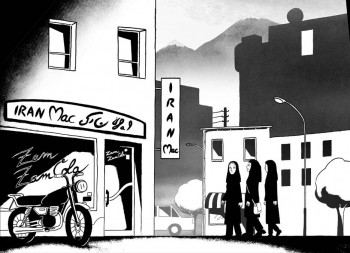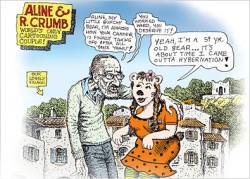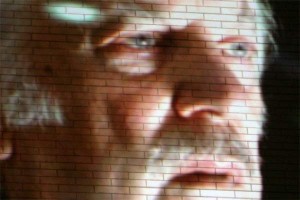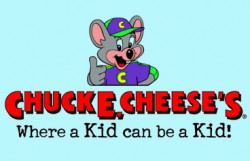Art Art &Daily post 20 Jan 2007 08:19 am
Accidental Art
 In the Sunday NYTimes, there is an article about the French animated feature, Persepolis. This is an animated adaptation of a graphic novel by Marjane Satrapi about the difficulties of being Iranian. She is codirecting the film with Vincent Paronnaud, a fellow comic book author who has also made a few short films. The English language version will feature the voices of Catherine Deneuve and Gena Rowlands. Kathleen Kennedy acted as the angel in chief getting the films into the hands of
In the Sunday NYTimes, there is an article about the French animated feature, Persepolis. This is an animated adaptation of a graphic novel by Marjane Satrapi about the difficulties of being Iranian. She is codirecting the film with Vincent Paronnaud, a fellow comic book author who has also made a few short films. The English language version will feature the voices of Catherine Deneuve and Gena Rowlands. Kathleen Kennedy acted as the angel in chief getting the films into the hands of  Sony Classics which will release it later this year.
Sony Classics which will release it later this year.
-
“I realized I had a talent I didn’t know,†she said. “In France people will tell you everything is impossible. I have the enthusiasm of an American. I tell people: ‘Rah, yes! We’re going to make a great movie.’ And it pays; you can see their reaction. And suddenly you realize they have ideas that you didn’t have. It is hard for me, for my ego, to say this: For me, the movie is better than the book.â€
The film is done in B&W. Perhaps it’s another Triplettes of Belleville? We can hope.
To hear an NPR interview with Marjane go here.
Buy the book here.
 The Sunday NYTimes also includes an article about the marriage of Robert & Aline Crumb and how they work together as cartoonists. The pair do a strip regularly for the New Yorker magazine.
The Sunday NYTimes also includes an article about the marriage of Robert & Aline Crumb and how they work together as cartoonists. The pair do a strip regularly for the New Yorker magazine.
They moved to France 16 years ago . . . sickened, they said, by the infiltration of their once sleepy California town, Winters, by newcomers who bulldozed hilltops for McMansions. The Crumbs also wanted to shield their daughter, Sophie, from a growing conservative and fundamentalist Christian influence while continuing to educate her in what they consider the classics. They reared her on “Little Lulu†comics from the 1940s and ’50s and Three Stooges videos.
It is a good, extensive article which gives an account of their present lives in the South of France.
There is also an audio slideshow on the Times site.
 – The Museum of Modern Art has a new exhibition of a film that is projected in a very big way on three walls of the Museum’s exterior. The film includes three different projections from 8 projectors of an overlapping story featuring Donald Sutherland and Tilda Swinton.
– The Museum of Modern Art has a new exhibition of a film that is projected in a very big way on three walls of the Museum’s exterior. The film includes three different projections from 8 projectors of an overlapping story featuring Donald Sutherland and Tilda Swinton.
There’s a wonderful presentation of this film-art-piece on a website called the Gothamist. I urge you to take a look.
This morning, I heard an interview with the artist talking about “Accidental Art,” by which he meant coming upon art without any such plans. The cab driver driving past the museum is taken with the odd film projecting off the building. The guy walking his dog sees something out of the corner of his eye and turns to find out what it is – Doug Aitken‘s projection.
This idea – “Accidental Art – has fascinated me for years. I remember, a while ago, projecting an old 30′s cartoon out the window of my 6th floor apartment. The image projected across the wide street onto a building across and, as a result, was probably 40 ft. wide or more. It was fun, but I’m not sure I considered that “Art.” Admittedly, it was a make-shift production, in that the film wasn’t planned for such a projection, and there was no point. I was merely entertaining myself and the rest of the party with me in the apartment.
I wonder if the projection happens specifically in the late-afternoon/evening? Or does it go on all day. Is it film or digital? From what I’ve read it seems to be all day. What story can be told? Is there a soundtrack and how is the sound broadcast? I’ll have to go up to the MOMA to find out the answers, and I will.
 For some reason this brings to my mind Douglas Trumbull‘s Showscan invention. I remember when Trumbull (the man behind the Effx in 2001 and Close Encounters) made films for Chucky Cheese using his Showscan method. Showscan‘s process was a 65mm film shot and projected at 60 frames per second (fps). Presumably, this allowed the brain to eliminate the flicker in films, and would result in a sort of 3D effect. Most movies are 24 fps.
For some reason this brings to my mind Douglas Trumbull‘s Showscan invention. I remember when Trumbull (the man behind the Effx in 2001 and Close Encounters) made films for Chucky Cheese using his Showscan method. Showscan‘s process was a 65mm film shot and projected at 60 frames per second (fps). Presumably, this allowed the brain to eliminate the flicker in films, and would result in a sort of 3D effect. Most movies are 24 fps.
I found this quote by someone who’d seen the process, Bob Wood:
- I can’t remember the specs but it was scarily real, 3-D, multi channel and way ahead of multi channel… or HDTV. I do remember it ran film through the gate much faster than normal projection speeds.
I had the brief opportunity of interviewing Trumbull on the process, and I asked, of course, if animation would have the same result. His response was that it should be the same as long as the animation was done at 60fps and projected that way. I never got to see the projection (there are no Chucky Cheese restaurants in Manhattan – thank god,) and he never did animation in the process.
Now Chucky Cheese is closed, Showscan is bankrupt, and Trumbull is involved with IMAX. I guess we won’t find out how his system would’ve worked with animation.

on 21 Jan 2007 at 12:00 am 1.Tom Minton said …
I always thought the only person crazy enough to animate at 60 fps would be Richard Williams, but not even he got around to it. I saw a Universal Studios attraction that featured a brief film shot in Showscan about a decade ago. The filming and projection speed resulted in a clarity that betrayed standard film artifice: props looked fake, makeup on actors’ faces became garishly obvious and painted props showed every brush stroke. Too bad it went under before it was effectively harnessed. The format did have promise, if only as a showcase for something all too rare in most movie houses anymore – razor-sharp focus.
on 21 Jan 2007 at 9:03 am 2.Michael said …
Actually, I think we do have Showscan now in a different form – HDTV. The same complaint seems to exist for that form – objects such as a news anchors’ desks seem fake, makeup is more obvious etc. I’ve also seen HD projections that are extraordinary (as well as others that are horrible.) I guess things just keep changing – Blue Ray or HDtv?
on 22 Jan 2007 at 8:14 am 3.slowtiger said …
One should really separate between fps (how many frames of film physically are shot, at least 15 per second for the illusion of motion) and actual projection situation where each frame is presented twice or thrice by means of a rotating shutter (which is the trick to eliminate flickering, which occurs at frequencies under about 50 Hz). Filming at real 60 fps would of course solve both problems in one pass, but is until now not economical, at least as long as film stock is used. AFAIK high definition, high speed digital cameras exist, but only for very special occasions and for astronomically high prices. A hand-drawn animation film’s production time would be at least four times as long at 60 fps than at 24 fps, with a budget four times as high.
On the other hand I heard people in animation software forums complain that movements which were interpolated by the software looked much too smooth, and they were asking about how to get back that “animating on 2′s” look.
on 22 Jan 2007 at 9:04 am 4.Michael said …
To get back that “animating on 2′s look” you just have to animate on 2′s. Or maybe it’s too hard to tell software how to animate on 2′s.
on 27 Jan 2007 at 6:46 am 5.slowtiger said …
No kidding, sometimes it is. The most common workaround seems to be to work in 12 fps and later stretch the rendered result. This of course makes it nearly impossible to incorporate “ones” where necessary, or be really flexible in your timing.